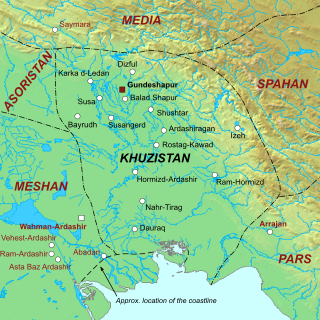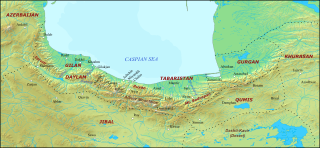Related Research Articles

Khosrow II, also known as Khosrow Parviz, is consider to be the last great Sasanian king (shah) of Iran, ruling from 590 to 628, with an interruption of one year.

Yazdegerd III (also spelled Yazdgerd III and Yazdgird III; Middle Persian: 𐭩𐭦𐭣𐭪𐭥𐭲𐭩; was the last Sasanian King of Kings of Iran from 632 to 651. His father was Shahriyar and his grandfather was Khosrow II.

Khuzestan Province is one of the 31 provinces of Iran. It is in the southwest of the country, bordering Iraq and the Persian Gulf. Its capital is Ahvaz and it covers an area of 63,238 square kilometres (24,416 sq mi). Since 2014 it has been part of Iran's Region 4.

The Muslim conquest of Persia, also known as the Arab conquest of Iran, led to the fall of the Sasanian Empire of Iran (Persia) in 651 and the eventual decline of the Zoroastrian religion.

The Muslim conquest of Khuzestan took place from 637/8 to 642, and ended with the acquisition of the rich Khuzestan Province by the Rashidun Caliphate.
Marzbān, or Marzpān were a class of margraves, warden of the marches, and by extension military commanders, in charge of border provinces of the Parthian Empire and mostly Sasanian Empire of Iran.

Tabaristan or Tabarestan, was the name applied to a mountainous region located in the Caspian coast of northern Iran. It corresponded to the present-day province of Mazandaran, which became the predominant name of the area from the 11th-century onwards.
Māhōē Sūrī, known in Islamic sources as Māhūy Sūrī, was an Iranian aristocrat, who served as the marzbān of Marv during the reign of the last Sasanian king of kings Yazdegerd III.

The Aswārān, also spelled Asbārān and Savaran, was a cavalry force that formed the backbone of the army of the Sasanian Empire. They were provided by the aristocracy, were heavily armored, and ranged from archers to cataphracts.

Hormuzan was an Iranian aristocrat who served as the governor of Khuzestan, and was one of the Sasanian military officers at the Battle of al-Qādisiyyah. He was later taken prisoner by the Muslims after the fall of Shushtar in 642. Two years later, he was accused of the assassination of the Rashidun caliph Umar, and was killed by 'Ubaid-Allah, the deceased caliph's son.
Farrukhzad, was an Iranian aristocrat from the House of Ispahbudhan and the founder of the Bavand dynasty, ruling from 651 to 665. Originally a powerful servant of the Sasanian king Khosrow II, he, along with several other powerful aristocrats made a conspiracy against the latter and ended his tyrannical rule. They thereafter put Khosrow's son Kavadh II on the throne, whose rule lasted only a few months, before he was killed by a plague, being succeeded by his son Ardashir III, who was only after one year murdered by the rebellious former Sasanian army chief (spahbed) Shahrbaraz, who usurped the throne.
Jalinus was a 7th-century Armenian dynast, who was one of the leading figures in Sasanian Iran. He was the commander of the guard over Khosrow II, during the latter's imprisonment. Jalinus was a Sasanian commander during the Arab conquest of Iran.
The Sasanian civil war of 628–632, also known as the Sasanian Interregnum was a conflict that broke out after the execution of the Sasanian king Khosrau II between the nobles of different factions, notably the Parthian (Pahlav) faction, the Persian (Parsig) faction, the Nimruzi faction, and the faction of general Shahrbaraz. Rapid turnover of rulers and increasing provincial landholder power further diminished the empire. Over a period of fourteen years and thirteen successive kings, the Sasanian Empire weakened considerably, and the power of the central authority passed into the hands of its generals, contributing to its fall.
Mihran-i Bahram-i Razi, better simply known as Mihran Razi, was an Iranian military officer from the Mihran family. He was killed in 637 at the battle of Jalula.
Azadveh-i Banegan Mahan-i Mihr-Bondad, known in Arabic sources as Azadhbih ibn Baniyan Mahan ibn Mihrbundadh, better simply known as Azadbeh, was an Iranian nobleman, who served as the Sasanian marzban of al-Hira in the period 617-633.

The Siege of Shushtar was fought from 641 to 642 between the Sasanian Empire and the invading Arab Muslims of the Rashidun Caliphate. Shushtar was an ancient strong stronghold in Khuzestan, and was attacked by the Arabs under their commander Abu Musa Ashaari. Although the city managed to resist the Arabs, the Sasanians later faced desertion, which resulted in the Arabs capturing the city and capturing its commander, Hormuzan.

Harev, was a Sasanian province in Late Antiquity, that lay within the kust of Khorasan. The province bordered Kushanshahr in the west, Abarshahr in the east, Marv in the north, and Sakastan in the south.
The Asawira were a military unit of the Rashidun and Umayyad Caliphate. The unit consisted of Iranian noblemen who were originally part of the aswaran unit of the Sasanian army. It was disbanded in 703 by al-Hajjaj ibn Yusuf.
Shiruya al-Uswari was an Iranian nobleman, who was part of the Sasanian asbaran unit, but later defected together with a faction of the unit to the Rashidun Caliphate, where the unit became known as the Asawira. He settled in Basra, and married a Sasanian princess called Marjana, whom he built a palace for on a canal in Basra

Pars was a Sasanian province in Late Antiquity, which almost corresponded to the present-day province of Fars. The province bordered Khuzestan in the west, Kirman in the east, Spahan in the north, and Mazun in the south.
References
- ↑ Zakeri 1995, p. 114.
- ↑ Jalalipour 2014, pp. 12-13.
- ↑ Bosworth 1987, pp. 706-707.
- ↑ Pourshariati 2008, p. 240.
- ↑ Zakeri 1995, p. 193.